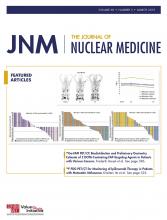Abstract
15O (half-life, 122 s) is a useful radionuclide for PET applications. Current production of 15O typically makes use of the 14N(d,n)15O, 15N(p,n)15O, or 16O(p,pn)15O reactions using an accelerator. A novel approach for the production of 15O is via the 16O(γ,n)15O reaction using an electron linear accelerator. Photonuclear reactions using an electron linear accelerator may allow for feasible and economical production of 15O compared with the current methods. Methods: In this work, experiments using a repurposed Clinac were conducted using oxygen-containing alumina as a target material to study the production rate of 15O. Additional studies were conducted using a water target cell. Simulations using Geant4 were conducted to predict the activity and power dissipation in the target. Results: Bremsstrahlung radiation from the electron beam, and consequently 15O production via photonuclear reactions, is enhanced when a high-Z material, tungsten, is placed in front of the target. The alumina irradiations provided preliminary data to optimize the beam parameters and target configuration. The optimal thickness of tungsten was 1.4 mm for both the simulated and the measured studies of alumina. Simulations of irradiated water targets showed that tungsten thicker than 1.4 mm resulted in fewer photons available to activate the water; thus, a higher current was required to achieve a fixed dose. Alternatively, for a constant tungsten thickness, more power was deposited in the target with increasing beam energy, requiring a lower current to achieve a fixed dose. Actual irradiations of a water target yielded a quantity of 15O in the water that was consistent with expectations based on irradiations of alumina. Conclusion: Several parameters should be considered regarding the photonuclear production of 15O for an average patient dose of 1,850 MBq (50 mCi) in 10 mL. This work illustrates a variety of machine parameters capable of achieving a reasonable patient dose. Our simulations show that the power deposited in the target for these parameters is less than that in commercially operated cyclotron targets for the production of 18F. Thus, this work demonstrates that the photonuclear production of 15O may be a new production path for this useful radionuclide.
Footnotes
Published online Sep. 20, 2018.
- © 2019 by the Society of Nuclear Medicine and Molecular Imaging.







